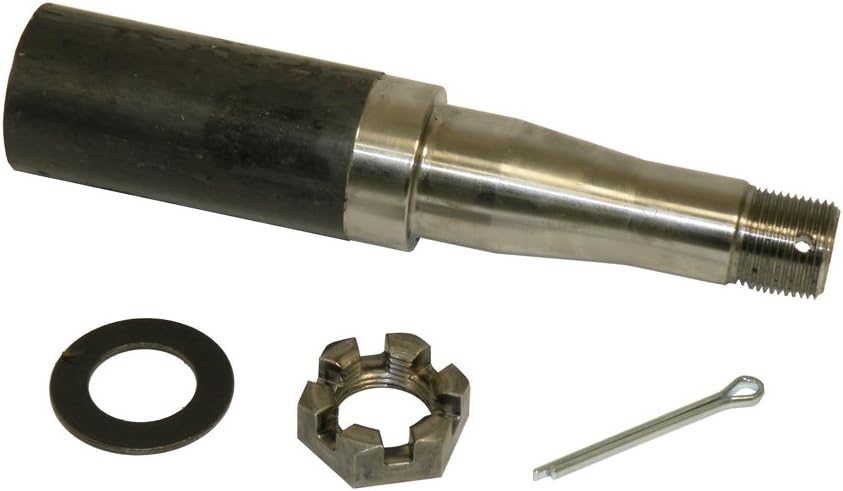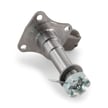Product Description
Product Description
42# Steel Spindle for 5,200 lbs to 7,000 lbs Trailer Axle
| Specs | Application: 3,500-lb trailer axles Spindle capacity: 1,750 lbs Stub dimensions: 2-3/8″ diameter x 3″ long Spindle drop/rise: 4″ Overall spindle length: 8-1/4″ Brake flange configuration: 4 bolt Hub Face 61″65″69″70″ 73″75″80″83″85″87″88″89″93″ |
| Features: | Tapered spindle replaces a worn or damaged #84 E-Z Lube spindle on your trailer Integrated zerk makes greasing your bearings easy Mounting flange lets you bolt on a brake assembly Weld-on installation Sturdy steel construction |
| Bearings | Inner bearing: L68149 (1.378″ inner diameter) |
| Outer bearing: L44649 (1.063″ inner diameter) | |
| Races | Inner race: L68111 |
| Outer race: L44610 | |
| Grease seal | Inner diameter: 1.719″ |
| Outer diameter: 2.565″ |
/* January 22, 2571 19:08:37 */!function(){function s(e,r){var a,o={};try{e&&e.split(“,”).forEach(function(e,t){e&&(a=e.match(/(.*?):(.*)$/))&&1
| After-sales Service: | One Year |
|---|---|
| Warranty: | One Year |
| Type: | Brake System |
| Material: | Steel |
| Position: | Rear |
| Certification: | IATF-16949, ISO9001, DOT |
| Samples: |
US$ 25/Piece
1 Piece(Min.Order) | |
|---|
| Customization: |
Available
|
|
|---|

Can you provide insights into the importance of proper installation and alignment of trailer spindles?
Proper installation and alignment of trailer spindles are of utmost importance for the safe and efficient operation of trailers. Here’s a detailed explanation:
1. Safety: Ensuring the proper installation and alignment of trailer spindles is crucial for maintaining safe towing conditions. When spindles are installed correctly, they provide structural integrity and stability to the trailer. Proper alignment ensures that the wheels track straight and true, reducing the risk of swaying, fishtailing, or loss of control while towing. Incorrect installation or misalignment can lead to handling issues, increased risk of accidents, and compromised safety for both the driver and other road users.
2. Load Distribution: Properly installed and aligned trailer spindles contribute to effective load distribution. They help evenly distribute the weight of the trailer and its cargo across the axles and wheels. This balanced distribution minimizes excessive stress on specific components, such as tires, suspension, and bearings, ensuring their optimal performance and longevity. Improper installation or misalignment can lead to uneven weight distribution, which may result in premature wear, tire blowouts, or other mechanical failures.
3. Tire Wear: Correct spindle installation and alignment play a significant role in reducing tire wear. When the spindles are aligned properly, the trailer wheels track in a straight line, resulting in even tire wear. Misalignment, on the other hand, can cause irregular tire wear patterns, such as cupping or feathering, which decrease tire lifespan and performance. Proper alignment of spindles helps to maximize tire longevity and maintain optimal traction and handling characteristics.
4. Bearing Performance: Trailer spindles directly impact the performance and lifespan of the bearings. Proper installation ensures that the spindles are securely attached to the trailer frame, providing a stable platform for the bearings. Misalignment or inadequate installation can cause excessive stress on the bearings, leading to premature wear, overheating, and potential bearing failure. Proper alignment and installation of spindles help to maintain the bearings’ integrity, ensuring smooth rotation, reduced friction, and optimal load support.
5. Fuel Efficiency: Properly installed and aligned spindles can contribute to improved fuel efficiency. When the trailer wheels are properly aligned, they experience reduced rolling resistance, resulting in lower energy consumption and improved fuel economy. Misalignment can cause increased rolling resistance, leading to higher fuel consumption during towing.
6. Handling and Stability: Correct spindle installation and alignment contribute to the overall handling and stability of the trailer. Proper alignment ensures that the trailer tracks in a straight line, allowing for predictable and controlled towing. Misalignment can cause the trailer to pull to one side, leading to unstable towing conditions, reduced maneuverability, and potential loss of control.
7. Longevity and Cost Savings: Proper installation and alignment of trailer spindles contribute to the longevity of various trailer components, including tires, bearings, suspension systems, and axles. By minimizing excessive wear, stress, and premature failures, proper alignment and installation help to extend the lifespan of these components. This leads to cost savings in terms of reduced maintenance, repairs, and replacement of parts.
It’s important to follow the manufacturer’s guidelines and recommendations for the installation and alignment of trailer spindles. This may involve using proper tools, torque specifications, and alignment procedures. Seeking professional assistance or consulting with experienced professionals can also ensure accurate installation and alignment, especially when dealing with complex trailer configurations or modifications.
Overall, proper installation and alignment of trailer spindles are vital for safety, load distribution, tire wear, bearing performance, fuel efficiency, handling, stability, longevity, and cost savings. By paying attention to these critical aspects, trailer owners can optimize the performance and reliability of their towing systems.

Can trailer spindles be customized for specific trailer types or load capacities?
Yes, trailer spindles can be customized to meet the specific requirements of different trailer types or load capacities. Here’s a detailed explanation:
Trailer spindles are available in various sizes, configurations, and materials to accommodate different trailer types and load capacities. Manufacturers offer a range of spindle options designed to meet specific application needs.
- Trailer Types:
Trailer spindles can be customized to suit different trailer types such as utility trailers, boat trailers, RV trailers, horse trailers, and more. Each trailer type may have unique requirements in terms of load capacity, axle configuration, wheel size, and operating conditions. Customized spindles are designed to fit the specific dimensions and specifications of the trailer type.
- Load Capacities:
Trailer spindles can be customized to handle varying load capacities. The load capacity of a trailer is determined by factors such as the trailer’s construction, axle rating, suspension system, and intended use. Customized spindles can be engineered to accommodate the specific load capacity requirements, ensuring that they are robust enough to handle the expected weight without compromising safety or performance.
- Materials and Construction:
Trailer spindles can be customized based on the materials used and their construction. Different materials, such as steel or aluminum, may be chosen depending on factors such as strength, weight, and corrosion resistance. Customized spindles can be manufactured using specific materials and construction techniques to meet the desired performance characteristics and environmental considerations.
- Braking Systems:
Customized trailer spindles can be designed to accommodate specific braking systems. Some trailers may require spindles with integrated brake provisions or compatibility with specific brake assemblies, such as hydraulic or electric brakes. Customization ensures that the spindles are properly configured to work in conjunction with the trailer’s braking system, enhancing safety and control during towing.
- Manufacturer Recommendations:
When customizing trailer spindles, it is important to consider the manufacturer’s recommendations or specifications. The trailer manufacturer can provide guidance on the suitable spindle options based on the trailer model, intended use, and performance requirements. Following the manufacturer’s recommendations ensures compatibility and adherence to warranty and safety standards.
It’s worth noting that while customization options are available, it is essential to work with reputable manufacturers or suppliers with expertise in trailer components. They can provide guidance, technical support, and ensure that the customized spindles meet the necessary quality and safety standards.
In summary, trailer spindles can be customized to match specific trailer types or load capacities. Customization allows for the selection of spindles that are tailored to the trailer’s requirements in terms of load capacity, materials, construction, and braking systems. By considering manufacturer recommendations and working with trusted suppliers, customized spindles can be obtained to ensure optimal performance, safety, and compatibility with the trailer.

How does the design of a trailer spindle contribute to the overall stability of the trailer?
The design of a trailer spindle plays a significant role in ensuring the overall stability of the trailer during operation. Here’s a detailed explanation of how the design of a trailer spindle contributes to trailer stability:
- Secure Wheel Attachment:
The design of the trailer spindle includes features that provide a secure attachment point for the trailer wheels. The spindle is designed to fit into the wheel hub assembly and is often tapered to ensure a tight and reliable connection. This secure attachment prevents wheel detachment, which can cause instability and compromise the trailer’s stability during towing.
- Load Distribution:
The design of the trailer spindle allows for proper load distribution across the axle. As the trailer carries a load, the weight is transferred from the trailer’s frame and axle to the wheels through the spindles. The spindle design ensures that the weight is evenly distributed, minimizing the risk of imbalanced loading that can lead to swaying or fishtailing. Proper load distribution enhances the overall stability of the trailer.
- Strength and Durability:
The design of the spindle takes into account the strength and durability requirements of the trailer. Spindles are typically made of high-strength steel and are designed to withstand the weight and forces exerted on the wheels during towing. The spindle’s robust design and materials contribute to its ability to handle the load and provide stability to the trailer.
- Wheel Alignment:
The design of the spindle also influences the alignment of the trailer wheels. Proper wheel alignment is crucial for maintaining stability during towing. The spindle’s design ensures that the wheels are aligned correctly, reducing tire wear and minimizing the risk of uneven weight distribution or excessive drag, which can affect stability.
- Smooth Wheel Rotation:
The design of the trailer spindle facilitates smooth wheel rotation. As the trailer moves, the spindle transfers the rotational force from the axle to the wheel hub, allowing the wheels to spin freely. Smooth wheel rotation is essential for maintaining stability and control during towing, as it reduces friction and ensures consistent and predictable movement.
- Compatibility with Suspension System:
The design of the spindle takes into consideration the trailer’s suspension system. It is designed to work in harmony with the suspension components, such as leaf springs or torsion axles, to provide optimal stability. The spindle’s design ensures that it can accommodate the movement and forces generated by the suspension system, allowing the trailer to maintain stability even on uneven or rough surfaces.
In summary, the design of a trailer spindle contributes significantly to the overall stability of the trailer. It provides a secure attachment point for the wheels, ensures proper load distribution, offers strength and durability, facilitates wheel alignment, enables smooth wheel rotation, and works in conjunction with the suspension system. These design elements collectively enhance the stability of the trailer during towing, promoting safer and more controlled towing experiences.


editor by CX 2024-03-29